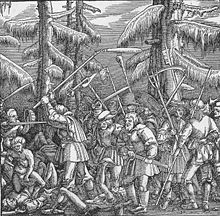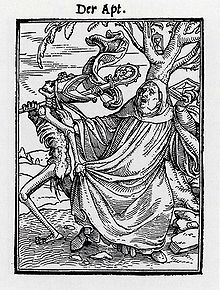Hans Lützelburger


Hans Lützelburger (died June 1526), also known as Hans Franck, was a German blockcutter ("formschneider") for
which Lützelburger left unfinished when he died.He is known to have been active, and already well-established, in Augsburg from c. 1516, where he was working, and signing the reverse of blocks,[3] under Jost de Negker, the other great blockcutter of the period, on the print projects for Maximilian I, Holy Roman Emperor involving Albrecht Dürer, Hans Burgkmair and other artists. In 1522 his "first undoubted masterpiece", the Battle of Naked Men and Peasants by Master NH (possibly Nicholaus Hogenberg),[4] was published, which in at least one edition carried an extra block in the margin below with his name as "FURMSCHNIDER" and the date in a tablet - a very unusual feature.[5] This also includes portraits of Lützelburger and the artist, naked except for cloths covering their genitals, pointing to the tablet.[6]
He was active from about 1522 in
He seems to have produced so much work in his last years at Basel that he may well have had assistants, although there is no documentation for this.
References
- ^ a b c Stein, Wilhelm (1920). Holbein der Jüngere. Berlin: Julius Bard Verlag. p. 108.
- ISBN 0-7141-2608-X
- Albertina, Vienna.
- ^ For Hogenberg, see the British Museum
- ^ Parshall 212-3, who speculates on the possible reasons.
- ^ We do not know for sure which is which, although Dodgson's suggestion was that Lützelburger is the figure on the left carrying a flagon and pointing with his finger. The figures were first pointed out by Dodgson in the 1909 article (p. 322), and their identification is now generally accepted - see Parshall.
- ^ Parshall, 216
- ^ Parshall 212-3; Bartrum 10-11
- ^ Parshall 212-3
- ^ Bartrum, 218-9,
Further reading
- ISBN 0-7141-2604-7
- Hans Lützelburger and the Master N.H. Campbell Dodgson, The Burlington Magazine, Vol. 10, No. 47 (Feb., 1907), pp. 319–322 JSTOR
- David Landau & Peter Parshall, The Renaissance Print, Yale, 1996, ISBN 0-300-06883-2
External links
- Works by Hans Lützelburger at Project Gutenberg
- Works by or about Hans Lützelburger at Internet Archive
- British Museum, Search on Hans Lützelburger here for 81 works.
- Dance of Death
- Dance of Death, including commentary, later images and copies by other artists.
